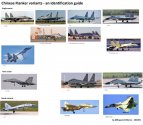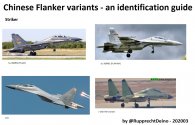by78
General
What visual aid? For what purpose? Are you making stuff up again?
I do believe Argentinean pilots did not have even radio altimeters in their planes in 1982, when they flew attack sorties on British ships, flying at 15 m (some more dubious sources say 10 m) above the sea during the approach to the enemy ship.
So I get that the J11/Su-27 is more of a pure air superiority fighter compared to J16/Su30MKK which is a strike fighter, but can anyone explain the actual physical differences?
Like what makes one more suited for the role than the other? I can't really tell any differences except the J11 kinda looks "slimmer" and it has one seat less?


Physically they kinda look the same, much like how a tandem seat F-15D looks a lot like an F-15E (especially when the Strike Eagle is stripped of its conformal fuel tanks).So I get that the J11/Su-27 is more of a pure air superiority fighter compared to J16/Su30MKK which is a strike fighter, but can anyone explain the actual physical differences?
Like what makes one more suited for the role than the other? I can't really tell any differences except the J11 kinda looks "slimmer" and it has one seat less?
What's the difference again between J-11B and J-11BH? is the former for PLAAF and the latter for PLANAF? Are there actually any physical differences between the two or it's just different designations?
What's the difference again between J-11B and J-11BH? is the former for PLAAF and the latter for PLANAF? Are there actually any physical differences between the two or it's just different designations?
